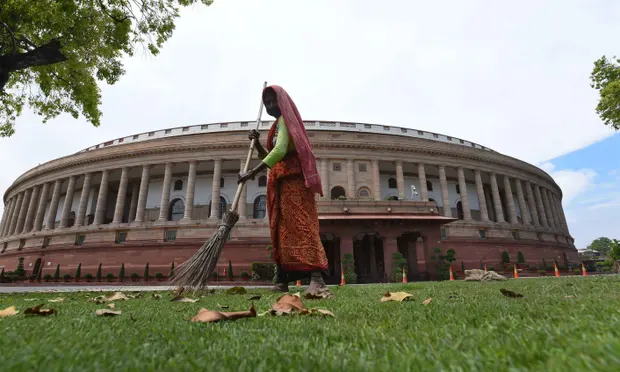Writing in the Guardian, the acclaimed Indian-born sculptor Anish Kapoor had earlier described the plans to rebuild the nation’s power corridor as an act of “political fanaticism” by Narendra Modi, "India’s Hindu-nationalist prime minister".
(Hindu priests and rituals at display !!
Narendra Modi carries a royal golden sceptre to be installed near the chair of the speaker during the inaugural ceremony of the new parliament building, in New Delhi Photograph: AP/The Guardian ) on May 28, 2023
The £100m parliament project had attracted controversy from the start, with the Modi government accused of rebuilding the corridors of power in its own image as part of a nationalistic political agenda. Launching the project in 2020, Modi had said the building would “become a witness to the creation of a self-reliant India”.
It was built at speed, taking less than three years, with an apparent unspoken deadline to have it completed before the 2024 general election when Modi will be seeking a third term in office.
The overall development, known as the Central Vista project, cost over $2.4bn and involved building a new government secretariat and a new prime minister’s residence and office. It was accused of a lack of transparency after it was awarded to architect Bimal Patel, who is from Modi’s home state of Gujarat and has been granted some of the most high-profile government projects in recent years.
But the government and the project’s architects had argued that the old building, which is almost 100 years old, was no longer fit for purpose and could not be adapted.
The new complex is three times larger than the old one and has room to seat more than 1,200 MPs, over 500 more than the original parliament. Though India now has 800 representatives across the upper and lower house, the numbers are up for review in 2026. Given the increase in India’s population to 1.4 billion people, the number of MPs could be raised.
According to the architect, materials and designs had been brought in from all over India to reflect the country’s cultural diversity and different architectural styles, including marble from Rajasthan and teak from Maharastra.
A sacred Sengol, a gold sceptre from the southern state of Tamil Nadu that is said to have been received by India’s first prime minister, Jawaharlal Nehru, on independence in 1947, was also placed by Modi in the new parliament chamber.
Modi tweeted after the ceremony. “May it propel our great nation to new heights of progress.”
The new Parliament complex envisages a new triangular Parliament building next to the existing complex.
Hundreds of members of the opposition parties were conspicuous by their absence. Earlier in the week, they had come together to announce a boycott of the ceremony, arguing it should be the country’s president, who is largely a ceremonial figure, not Modi who inaugurated the parliament building, calling it a violation on the constitution and parliamentary procedure.
Since Modi was elected in 2014, he has been accused of dismantling democracy in India and overseeing an unprecedented centralisation of power. In an open letter, opposition groups described Modi’s Bharatiya Janata party (BJP) government as “authoritarian” and said Modi’s decision “to inaugurate the parliament building by himself, completely sidelining president Murmu, is not only a grave insult but a direct assault on our democracy … When the soul of democracy has been sucked out [of] parliament, we find no value in a new building.”
The BJP hit back, calling on opposition parties not to “politicise” the ceremony.
The long and grassy avenue sweeps down from the India Gate war memorial to the Rashtrapati Bhavan, or president’s residence, with the circular Parliament House building in between. It was designed by British architects Lutyens and Herbert Baker following the 1911 decision to move the capital of the British Raj from Calcutta to Delhi.







No comments:
Post a Comment